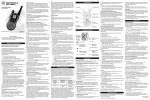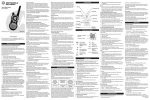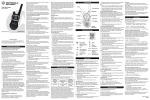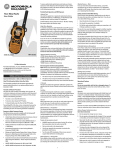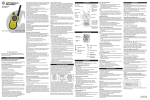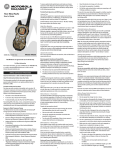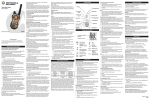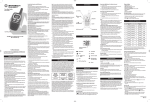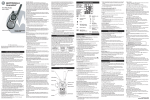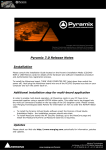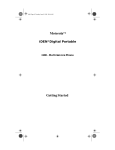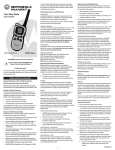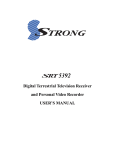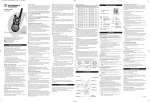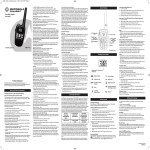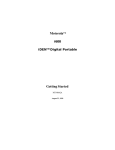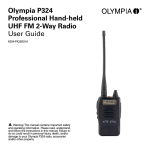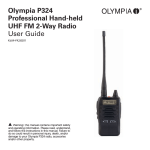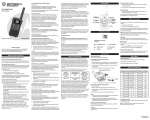Download Motorola MT352TPR Two-Way Radio User Manual
Transcript
Body-Worn Operation To maintain compliances with FCC/Health Canada RF exposure guidelines if you wear a radio on your body when transmitting always place the radio in a Motorola-supplied or approved clip holder, holster, case or body harness for this product. Use of non-Motorola-approved accessories may exceed FCC/Health Canada RF exposure guidelines. ® Two-Way Radio User Guide If you do not use one of the Motorola-supplied or approved body-worn accessories and are not using the radio held in the normal use position, ensure the radio and its antenna are at least 1 inch ( 2.5 cm) from your body when transmitting. Data Operation If applicable, when using any data feature of the radio with or without an accessory cable, position the radio and its antenna at least one inch ( 2.5 cm) from the body. Approved Audio Accessories • 53724: Remote Speaker with Push-to-Talk Microphone • 53725: Headset with Swivel Boom Microphone • 53727: Earbud with Push-to-Talk Microphone • 53728: Flexible Ear Receiver • 56320: Earpiece with Boom Microphone Electromagnetic Interference/Compatibility Note: Nearly every electronic device is susceptible to electromagnetic interference (EMI) if inadequately shielded, designed or otherwise configured for electromagnetic compatibility. This device complies with Part 15 of the FCC Rules. Operation is subject to the following two conditions: MT Series KEM-ML34301A 1. This device may not cause harmful interference; and 2. This device must accept any interference received, including interference that may cause undesired operation. IC Canada The term "IC:" before the equipment certification number only signifies that the Industry Canada technical specifications were met. For More Information For further information, you may call Motorola Solutions, Inc. at 1-800-6385119 (U.S. and Canada), e-mail us at [email protected] or visit us on the Internet at motorolasolutions.com/talkabout. Safety and General Information Important Information on Safe and Efficient Operation Read This Information Before Using Your Radio. The information provided in this document supersedes the general safety information in user guides published prior to December 1, 2002. Transmit and Receive Procedure Your two-way radio contains a transmitter and a receiver. To control your exposure and ensure compliance with the general population/ uncontrolled environment exposure limits, always adhere to the following procedure: • Transmit no more than 50% of the time. • To receive calls, release the PTT button. • To transmit (talk), press the Push to Talk (PTT) button. Transmitting 50% of the time, or less, is important because the radio generates measurable RF energy exposure only when transmitting (in terms of measuring standards compliance). Exposure to Radio Frequency Energy Your Motorola two-way radio complies with the following RF energy exposure standards and guidelines: • United States Federal Communications Commission, Code of Federal Regulations; 47CFR part 2 sub-part J. • American National Standards Institute (ANSI)/Institute of Electrical and Electronic Engineers (IEEE) C95. 1-1992. • Institute of Electrical and Electronics Engineers (IEEE) C95. 1-1999 Edition. • International Commission on Non-Ionizing Radiation Protection (ICNIRP) 1998. Facilities To avoid electromagnetic interference and/or compatibility conflicts, turn off your radio in any facility where posted notices instruct you to do so. Hospitals or health care facilities may be using equipment that is sensitive to external RF energy. Aircraft When instructed to do so, turn off your radio when onboard an aircraft. Any use of a radio must be in accordance with applicable regulations per airline crew instructions. Medical Devices – Pacemakers The Advanced Medical Technology Association recommends that a minimum separation of 6 inches (15 cm) be maintained between a handheld wireless radio and a pacemaker. These recommendations are consistent with the independent research by and recommendations of the U.S. Food and Drug Administration. People with pacemakers should: • ALWAYS keep the radio more than 6 inches (15 cm) from their pacemaker when the radio is turned ON. • Not carry the radio in the breast pocket. • • Use the ear opposite the pacemaker to minimize the potential for interference. Turn the radio OFF immediately if there is any reason to suspect that interference is taking place. Medical Devices – Hearing Aids Some digital wireless radios may interfere with some hearing aids. In the event of such interference, you may want to consult your hearing aid manufacturer to discuss alternatives. Medical Devices – Other If you use any other personal medical device, consult the manufacturer of your device to determine if it is adequately shielded from RF energy. Your physician may be able to assist you in obtaining this information. Safety and General Use While Driving Check the laws and regulations regarding the use of radios in the area where you drive, and always obey them. If you do use your radio while driving, please: • Give full attention to driving and to the road. Ministry of Health (Canada) Safety Code 6. Limits of Human Exposure to Radiofrequency Electromagnetic Fields in the Frequency Range from 3 KHz to 300 GHz, 1999. • Use hands-free operation, if available. • Pull off the road and park before making or answering a call if driving conditions so require. • Australian Communications Authority Radiocommunications (Electromagnetic Radiation—Human Exposure) Standard, 2003. • ANATEL ANNEX to Resolution No. 303 of July 2, 2002. The use of a two-way radio while engaged in activities requiring concentration may cause distraction or otherwise impair your ability to safely participate in such activities. Always use technology safely. • ANATEL ANNEX to Resolution No. 533 of September 10, 2009. • To ensure optimal radio performance and make sure human exposure to radio frequency electromagnetic energy is within the guidelines set forth in the above standards, always adhere to the following procedures. Portable Radio Operation and EME Exposure Antenna Care Use only the supplied or an approved replacement antenna. Unauthorized antennas, modifications, or attachments could damage the radio and may violate FCC regulations. Do NOT hold the antenna when the radio is “IN USE.” Holding the antenna affects its effective range. Do not place a portable radio in the area over an air bag or in the air bag deployment area. Air bags inflate with great force. If a portable radio is placed in the air bag deployment area and the air bag inflates, the radio may be propelled with great force and cause serious injury to occupants of the vehicle. Potentially Explosive Atmospheres Turn off your radio prior to entering any area with a potentially explosive atmosphere. Only radio types that are especially qualified should be used in such areas as “Intrinsically Safe.” Do not remove, install or charge batteries in such areas. Sparks in a potentially explosive atmosphere can cause an explosion or fire resulting in bodily injury or even death. Push to Talk (Low) Scroll/Weather Call Tone Flash Light Blasting Caps and Areas Button To avoid possible interference with blasting operations, turn off your radio when you are near electrical blasting caps, in a blasting area, or in areas posted “Turn off two-way radios.” Obey all signs and instructions. Scroll/Weather Antennas damaged antenna. If a Do not use any portable radio that has a Microphone damaged antenna comes into contact with your skin, a minor burn can Mini-USB result. Batteries Charging Port Radio Battery Meter The radio battery icon shows the battery charge level, from full . When the radio has one segment left, the empty Control Buttons Note: The areas with potentially explosive atmospheres referred to above include fueling areas such as below decks on boats, fuel or chemical transfer or storage facilities, areas where the air contains chemicals or particles (such as grain, dust or metal powders) and any other area where you would normally be advised to turn off your vehicle engine. Areas with potentially explosive atmospheres are often—but not always—posted. Menu/ Keypad Lock MT350 radio chirps periodically or after releasing Emergency Alert Scan/Monitor 2. With the back of the radio facing you, loosen the retaining screw on the battery door and open the cover. 3. Remove the NiMH battery pack by pulling the ribbon attached to the radio. Volume Emergency Alert Volume Operational Cautions All batteries can cause property damage and/or bodily injury such as burns if a conductive material—like jewelry, keys or beaded chains— touch exposed terminals. The conductive material may complete an electrical circuit (short circuit) and become quite hot. Exercise care in handling any charged battery, particularly when placing it inside a pocket, purse or other container with metal objects. LED Indicator Accessory Port Push to Talk (Low) Menu/ Keypad Lock Call Tone Flash Light Button MENU Scan/Monitor MON Scroll/Weather Microphone Mini-USB Charging Port Speaker Flash Light LED —Vibrate —Scan Numbers for Channel, Call Tone —Keypad Lock —Talk Confirmation Tone (Roger Beep) —Noise Filtering —On/Off for each feature The pins on the plug of the extension cord are the same number, size and shape as those on the plug of the charger. • The extension cord is properly wired and in good condition. • The extension cord size is 18 AWG for lengths up to 100 feet, and 16 AWG for lengths up to 150 feet. 9. The supply cord of the AC adaptor cannot be replaced. If the cord is damaged, call customer service at 1-800-638-5119 (U.S. and Canada) or e-mail us at [email protected]. Licensing Information Your Motorola radio operates on FRS & GMRS frequencies in Canada & in the USA. For Canadian citizens, use of these frequencies is subject to the rules & regulations of Industry Canada (IC). IC requires no license when operated in Canada. For USA citizens, use is subject to the rules and regulations of the Federal Communications Commission (FCC) . The FCC requires that all operators using GMRS frequencies obtain a radio license before operating their equipment. To obtain the FCC forms, please visit the FCC’s Web site at wireless.fcc.gov/uls/index.htm?job=home to source form 605 and 159, which includes all the instructions you will need. If you wish to have the document faxed or mailed, or if you have questions, please use the following contact information: For a fax: Contact the Fax-0n-Demand system For mail service: Call the FCC Forms Hotline If you have questions about the FCC License: Call the FCC 1-202-418-0177 1-800-418-FORM (3676) 1-888-CALL-FCC (225-5322) Changes or modifications not expressly approved by Motorola may void the user’s authority granted by the IC/FCC to operate this radio and should not be made. To comply with IC/FCC requirements, transmitter adjustments should be made only by or under the supervision of a person certified as technically qualified to perform transmitter maintenance and repairs in the private land, mobile and fixed services as certified by an organization representative of the user of those services. Replacement of any transmitter component (crystal, semiconductor, etc.) not authorized by the IC/FCC equipment authorization for this radio could violate IC/FCC rules. Note: Use of this radio outside the country where it was intended to be distributed is subject to government regulations and may be prohibited. —Dual Scan —Call Tone, Keypad Tone —Weather Alert —Hands-Free Use Without Accessories —Hands-Free Use With Accessories Speaker —Keypad Lock —Talk Confirmation Tone (Roger Beep) —Noise Filtering —On/Off for each feature —Dual Scan —Call Tone, Keypad Tone 4. Close the battery cover and tighten the retaining screw on the battery door. • —Battery Meter —Vibrate —Channel Power Indicator (see menu Options) —Scan Remove the batteries before storing your radio for extended periods of time. Batteries corrode over time and may cause permanent damage to your radio. Flash Light LED —Keypad Lock —Talk Confirmation Tone (Roger Beep) —Dual Scan —Call Tone, Keypad Tone —Weather Alert —Hands-Free Use Without Accessories —Hands-Free Use With Accessories Available mini-USB charging options: 1. Vehicle charger This and other accessories (sold separately) are available for your radio. For more information, visit our Web site at motorolasolutions.com/talkabout or shop.giantintl.com. 1. Plug your mini-USB cable or charger into a power source as is appropriate for your accessory. 2. Plug the cable into the mini-USB port on the bottom of your radio. —Weather Alert —Hands-Free Use Without Accessories —Hands-Free Use With Accessories Getting Started Weatherproof This radio is weatherproof to IP-54 standards. It is dust/splashproof from any direction. The radio is resistant to water and rain splashes only when the battery cover and headset accessory mini-USB ports are sealed. Open the battery compartment door or headset port cover only when the radio is dry. Use of a headset accessory should be in dry environments only. 3. After the initial charge, an empty battery will be fully charged in 7 hrs. for the MT350 series radio (KEBT-650 mAh NiMH battery pack) or 14 hrs. for the MT352 series radio (KEBT-1300 mAh NiMH battery pack). Notes • When moving between hot and cold temperatures, do not charge the NiMH battery pack until the battery temperature acclimates (usually about 20 minutes). • For optimal battery life, remove the radio from the charger within 16 hours. Do not store the radio while connected to the charger. • If the radio is kept on while charging, the charging time will be extended. • Even though the charger is connected, you may not be able to transmit a message if the battery is completely empty . Allow time for the battery to charge to 1 bar before attempting to transmit a message. Attaching and Removing the Belt Clip 1. Attach belt clip to pocket or belt strap. 3. Gently push until the clip clicks in place. Installing the Batteries Each radio can use either 1 NiMH rechargeable battery pack or 3 AA alkaline batteries and beeps when the batteries are low. To Remove 1. Push down on the release tab at the top of the belt clip to release the catch. 2. With the back of the radio facing you, loosen the retaining screw on the battery door and open the cover. 3. Remove the NiMH battery pack from the clear plastic bag (do not disassemble or unwrap the battery pack). 4. Insert the NiMH battery pack with the diagram facing you. (The ribbon should be underneath the battery pack and should wrap around the right side of the pack for easy removal.) 5. Close the battery cover and tighten the retaining screw on the battery door. Installing the Three AA Alkaline Batteries ( Optional Accessory) 1. Turn the radio off. 2. With the back of the radio facing you, loosen the retaining screw on the battery door and open the cover. 3. Insert the three AA alkaline batteries with + and - polarity as shown inside. (The ribbon should be underneath the AA alkaline batteries and should wrap around the right side of the batteries.) 4. Close the battery cover and tighten the retaining screw on the battery door. until you reach a 1. Rotate clockwise to increase the volume. 2. Rotate counterclockwise to decrease the volume. Do not hold the radio close to your ear. If the volume is set to an uncomfortable level, it could hurt your ear. Talking and Listening Numbers for Cha To communicate, all radios in your group must be set to the same Call Tone channel and Interference Eliminator Code. 1. To talk, press and hold 2. Align the belt clip post with the hole in the back of the radio. 2. Pull the belt clip away from the back of the radio. Using the Desktop Battery Charger ( Optional Accessory) The battery charger provides drop-in charging convenience for NiMH batteries and can be placed on any flat surface, such as a desk or workbench. Charge the NiMH battery overnight (at least 16 hours) before using it for the first time. MT350R Radio After the initial charge, an empty battery (KEBT-650 mAh NiMH) is fully charged within 7 hrs. MT352R Radio After the initial charge, an empty battery (KEBT-1300 mAh NiMH) is fully charged within 14 hrs. 1. Follow the steps above to install a NiMH Battery Pack. 2. Plug the AC power supply cord into the jack on the desk stand. 3. Plug the AC power supply into a standard wall outlet. 4. With a radio facing forward, slide it into one of the charging pockets. 5. When charging in the battery charger, the red light on the charger base will glow continuously. . 2. When you are finished talking, release Numbers for Cod . For maximum clarity, hold the radio two to three inches away from your mouth and speak directly into the microphone. Do not cover the —Battery M microphone while talking. —Channel P Talk Range Indicator Your radio is designed to maximize performance and improve (see menu transmission range. Do not use the radios closer than five feet apart. —Keypad Lo Power Boost To boost your radio’s power up to high power, press the top portion of the —Talk Confi button when talking. If you know your party is close by, you can Tone (Rog conserve your battery’s energy by pushing the lower part of the button to use less power. —Noise Filt Note: If you are on an FRS only channel (see Channels and Frequencies table) the radio will only use low power when either portion of the—On/Off fo feature is pressed. Monitor Button Pressing and holding for three seconds allows you to listen to the volume level of the radio when you are not receiving. This allows you to adjust the volume, if necessary. You can also press to check for activity on the current channel before you talk. Push to Talk Timeout Timer To prevent accidental transmissions and save battery life, the radio emits a continuous warning tone and stops transmitting if you press for 60 continuous seconds. 4. The battery icon will scroll as the battery is being charged. The scrolling icon will stop when the battery is fully charged. The charging base and AC adaptor are not waterproof. Do not expose the charger to rain or snow. Charge the radios only in a dry location. Do not place wet radios into the charging base. The battery door must be tightly closed with the screw to maintain the weatherproof seal of the radio. Installing NiMH Rechargeable Battery Pack 1. Turn the radio off. Setting the Volume Press and hold for three seconds, then rotate comfortable listening level. Flash Light LED 3. Gently remove each alkaline battery by easing each battery out individually. If using a computer, the computer must be turned on. —Scan 2. The display screen then shows the current channel, code and all features that are enabled. Speaker 2. Mini-USB computer cable —Vibrate 1. In the ON position, the radio chirps and briefly shows all feature icons available on the radio. 2. With the back of the radio facing you, loosen the retaining screw on the battery door and open the cover. Using the mini-USB Charging Adaptor The mini-USB charging adaptor allows you to conveniently charge your NiMH battery pack. This is an alternative to charging your NiMH battery pack in the Battery Charger desk stand using the AC wall adaptor and especially useful when used while traveling. Numbers for Codes —Channel Power Indicator (see menu Options) • Scan/Monitor MON —On/Off for each feature —Channel Power Indicator (see menu Options) 5. To reduce the risk of electric shock, unplug the charger from the outlet before attempting any maintenance or cleaning. 8. An extension cord should not be used unless absolutely necessary. Use of an improper extension cord could result in a risk of a fire and/or electric shock. If an extension cord must be used, make sure that: MENU Scroll/Weather Microphone Mini-USB Charging Port —Noise Filtering —Battery Meter —Battery Meter 7. Make sure the cord is located so it will not be stepped on, tripped over or subjected to damage or stress. Menu/ Keypad Lock Numbers for Codes 4. To reduce the risk of damage to the cord or plug, pull the plug rather than the cord when disconnecting the charger from the AC receptacle. 6. Use of an attachment not recommended or sold by Motorola may result in a risk of fire, electric shock or personal injury. Call Tone Flash Light Button Notes • Exercise care when removing NiMH or AA batteries. Do not use sharp or conductive tools to remove either of these batteries. Numbers for Codes 3. Never alter the AC cord or plug provided with the unit. If the plug will not fit the outlet, have the proper outlet installed by a qualified electrician. An improper condition can result in a risk of electric shock. Removing the Three AA Alkaline Batteries ( Optional Accessory) 1. Turn the radio off. Numbers for Channel, Call Tone Numbers for Channel, Call Tone 2. Do not operate or disassemble the charger if it has received a sharp blow, or has been dropped or damaged in any way. LED Indicator Push to Talk (High) Push to Talk (Low) Display Screen Guide 1. Do not expose the charger to rain or snow. 4. Close the battery cover and tighten the retaining screw on the battery door. Accessory Port Push to Talk (High) Exercise care when removing NiMH or AA batteries. Do not use sharp or conductive tools to remove either of these batteries. Battery Charger Safety Instructions: Save these Instructions (Low Battery Alert). Drawing Battery Packbest fitting for UG Removing the NiMH Line 1. Turn the radio off. MON MENU to Microphone Turning your Radio On and Off clockwise to turn the radio on and counterclockwiseMini-USB to turn the Turn Charging Port radio off. Menu Options Selecting the Channel Your radio has 22 channels. The channel is the frequency the radio uses to transmit. Channels 8-14 are FRS 0.5 watt only and all other channels are GMRS. (See the "Channels and Frequencies" table on overleaf for details.) 1. With the radio on, press watt channel, channel, . When the radio is on a 0.5 displays. When the radio is on a 1.5 watts displays. The current channel flashes. 2. Press or and select an unused or quiet channel. 3. Press to save the channel setting or to continue set up. Selecting the Interference Eliminator Code Interference Eliminator Codes help minimize interference by blocking transmissions from unknown sources. Your radio has 121 Interference Eliminator Codes. Codes 1 – 38 are the standard analog codes that appear on other FRS/GMRS radios. Codes 39 – 121 are additional digital codes added for superior interference protection. 0 is the off position, no analog or digital codes are enabled. To set the code for a channel: 1. Press until the code starts to flash. 2. Press or 3. Press to save the code setting or to select the code. to continue set up. You can set a different code for each channel using this procedure. An extended press of or allows you to scroll through the Interference Code rapidly so you can quickly reach the code you want. Note: You must set the Interference Eliminator Code to 0 on a radio that uses Interference Eliminator Codes to communicate with radios that do not have Interference Eliminator Codes. Select 0 for “no tone, no code” and OFF will flash on your radio’s display. Setting and Transmitting Call Tones Your radio can transmit different call tones to other radios in your group so you can alert them that you want to talk. Your radio has 20 call tones from which to choose. To set a call tone: 1. Press three times until the current call tone setting flashes and appears. 2. Press or to change and hear the call tone. Continued on back MT Series 3. Press to set the new call tone or to continue set up. To transmit your call tone to other radios set to the same channel and Interference Eliminator Code as your radio, press . Note: Setting the call to 0 disables the call tone feature. ) Hands-Free Use Without Accessories ( You can use the iVOX feature to transmit hands-free without the need for any headset accessories. Once iVOX is turned on, the radio detects your voice and transmits when you speak into the internal microphone. 1. Press until On/Off will flash. appears on the display. The current setting 2. Press or 3. Press to set or • • Low battery alert tone or The transmitted talk confirmation tone Transmitting a Talk Confirmation Tone You can set your radio to transmit a unique tone when you finish transmitting. It is like saying “Roger” or “Over” to let others know you are finished talking. 1. With the radio on, press On/Off flashes. 2. Press 3. Press or until the appears. The current setting to turn On or Off. to set or to quit menu mode. Dual Watch Scan This feature allows you to monitor two channels at the same time. to select On or Off. to continue set up. 1. Press the Hands-Free Use With Accessories ( ) You can transmit hands-free more reliably with the use of optional headset accessories. Once VOX is turned on, the radio detects your voice and transmits when you speak. Many accessories (sold separately) are available for your radio. For more information, visit our Web site at motorolasolutions.com/talkabout or shop.giantintl.com. 1. Turn the radio off and plug the VOX accessory into the accessory port. button until the Dual Channel Scan icon displays. or buttons to select the second channel for Dual 2. Press the Watch reception. (if you want to disable the Dual Watch function, set it to ‘OFF’). Setting the Sensitivity Level When in Mode Adjusting the radio’s sensitivity level helps minimize the possibility of unintended noises triggering a transmission and helps the radio pick up soft voices. 1. Press display. until VOX and the level setting (1 - 3) appear on the 2. Press or 3. Press to set or to continue set up. 3 = High Sensitivity for quiet environments 2 = Medium Sensitivity for most environments 1 = Low Sensitivity for noisy environments Note: When you connect a headset, the radio is automatically set to the last chosen sensitivity level. QT Noise Filtering The QT noise-filtering feature helps to ensure uninterrupted communication with other Motorola radios that have this feature. This feature also filters out unwanted transmissions from other radios. This is useful in places where there is heavy radio traffic, such as amusement parks or ski resorts. Note: QT noise filtering is not available when the radio is scanning. To turn QT noise filtering on or off: 1. Press until displays. The current setting On/Off will flash. 2. Press or to turn noise filtering On or Off. 3. Press to confirm your selection or to continue set up. To transmit to a radio that has QT noise filtering turned on: 1. Select the same channel and Interference Eliminator Code as the other radio. 2. Press to send a call tone. This allows your voice to pass through the QT noise filter on the receiving radio. 3. Press and speak normally. Note: If you skip step 2, the beginning of your message may not be heard on the receiving radio. For a 30-second period, starting after the last transmission, all transmissions received on the selected channel and code will pass through the QT noise filter. VibraCallTM Alert VibraCallTM is a vibrating alert that notifies you that your radio is receiving a message. This is useful in noisy environments. When the alert is on, the radio vibrates once every 30 seconds when you receive a message on the channel and code you set. 1. To turn vibrating alerts on, press current setting will flash. 2. Press or 3. Press to set or until is displayed. The to change the setting to On/Off. to continue set up. Keypad Tones You may enable or disable the speaker key tones. You will hear the key tone each time a button is pushed. 1. Press until 2. Press either 3. Press appears. The current setting On/Off will flash. or to turn On or Off. to confirm or to continue set up. Note: When the key tone feature is off, the following are not disabled: • • Transmit timeout alert tone Call tone 5. To stop scanning, briefly press the key. To start Advanced Scanning: 1. Set the Interference Eliminator Code to “zero” or OFF. key. The scan will appear in the display, and 2. Briefly press the the radio will begin to scroll through the channels. No Interference Eliminator Codes will filter what is heard. 2. The scan icon will appear in the display, and the channel will scroll through the NOAA channels 1-7. 3. When the radio detects channel activity, it stops scanning and you can hear the transmission. 4. You may resume the scan by briefly pressing 5. To stop scanning, briefly press the disappear. 3. When the radio detects channel activity with ANY code (or NO code), it stops scrolling and you can hear the transmission. Any Interference Eliminator Code that may be in use by that party will be detected and displayed. or . key. The scan icon will Weather Channels and Frequencies within five 4. To respond and talk to the person transmitting, press seconds of the end of the transmission. The radio will transmit using the newly detected Interference Eliminator Code. Weather Channel Frequency Weather Channel Frequency WX1 162.550 MHz WX7 162.525 MHz WX2 162.400 MHz WX8 161.650 MHz The active channel will display for five (5) seconds after any activity has ended on the dual channel. You may talk on the Dual Watch channel during this period. 6. To stop scanning, briefly press the WX3 162.475 MHz WX9 161.775 MHz WX4 162.425 MHz WX10 161.750 MHz WX5 162.450 MHz WX11 162.000 MHz WX6 162.500 MHz or the PTT button to confirm the channel selection. Special Features Emergency Alert Mode The Emergency Alert feature can be used to signal members in your group of your need for urgent help. MT series radios will operate in an automatic “hands-free” emergency control mode for a total of 30 seconds after activating the Emergency Alert. MT series radios in your group will automatically advance the speaker volume to the maximum setting and sound a warbling alert tone for 8 seconds. The alert tone is emitted from your own radio speaker and the receiving radios in your group. After the 8 second alert, any spoken words or incidental sounds at your end will be transmitted to the group for 22 seconds. For the 30 second duration of Emergency Alert mode, MT series radio controls and buttons will be locked to maximize reception of the emergency message. 1. Press and hold the Emergency Alert button for 3 seconds. to select the sensitivity level. 4. The radio will resume scrolling through the channels five seconds after the end of any received activity. Scanning for Weather Channel The radio can scan for an active NOAA transmission automatically. 1. After turning weather reception on, briefly press the key. 5. The radio will resume scrolling through the channels five seconds after the end of any received activity. 3. Press . Lower the volume 3. Adjust the volume appropriately by rotating before placing the accessory on your head or in your ear. Note: There is a short delay between the time you start talking and when the radio transmits. There is a short delay before the transmission is completed. within five When the Dual Watch feature is activated, the radio will switch sequentially between the primary and the Dual Watch channels. 2. Turn the radio on. VOX shows on the display. 4. To turn off, simply remove accessory. 3. To respond and talk to the person transmitting, press seconds after the end of the transmission. 2. Release the button after the LED Indicator glows red and the alert tone begins to sound. There is no need to continue to hold the Emergency Alert button or use PTT for your message to be transmitted. 3. After the alert tone ends you may speak into the microphone. Your voice or incidental sounds will be transmitted. The LED indicator will continue to glow for the duration of the 22 second period. 4. After 30 seconds your radio speaker will emit a Talk Confirmation Tone and the LED Indicator will extinguish. Operation then returns to normal two-way mode. Note: All Motorola Talkabout EM, MJ, MR, and MT series radios are fully compatible with the Emergency Alert feature. Radios other than EM, MJ, MR, and MT series can receive the emergency alert signal, but will not respond with adjusted volume settings, locked controls, or a warbling alert tone. Users of other radio models set to the same channel and Interference Eliminator Code will hear a steady tone for 8 seconds followed by the voice transmission for 22 seconds. Warning: The Emergency Alert feature should only be used in the event of an actual emergency. Motorola is not responsible if there is no response to the emergency alert from the receiving group. Built-in Flashlight Press and hold the flashlight button to turn and keep the light on. The switch functions as a momentary control for the light. Note: Turn off the flashlight when not in use to conserve battery power. Keypad Lock To avoid accidentally changing your radio settings: 1. Press and hold until displays. 2. When in lock mode, you can turn the radio on and off, adjust the volume, receive, transmit, send a call tone, and monitor channels. All other functions are locked. To unlock the radio, press and hold until is no longer displayed. Scanning Channels Use scan to search the 22 channels for transmissions from unknown parties, to find someone in your group who has accidentally changed channels, or to quickly find unused channels for your own use. There is a priority feature and 2 modes of scanning ( basic and advanced ) to make your search more effective. The basic scan mode uses the channel and code combinations for each of the 22 channels as you have set them ( or with the default code value of 1). The “Advanced Scan” mode will scan all channels for any and all codes, detect any code in use, and use that code value temporarily for that channel. Priority is given to the “home channel,” that is, the channel (and Interference Eliminator Code) your radio is set to when you start the scan. This means the initial channel (and code setting) is scanned more often than the other 21 channels, and your radio will respond quickly to any activity occurring on the home channel as a priority. To start Scanning: 1. Briefly press the key. The scan will appear in the display, and the radio will begin to scroll through the channel and code combinations. 2. When the radio detects channel activity matching the channel and code combination, it stops scrolling and you can hear the transmission. key. Scanning Notes: while the radio is scrolling through inactive 1. If you press channels, the transmission will be on the “home channel”. Scanning will resume five seconds after the end of your transmission. You may press the key to stop scanning at any time. 2. If the radio stops on an undesired transmission, you may immediately resume the scan by briefly pressing or . 3. If the radio repeatedly stops on an undesired transmission, you may temporarily remove that channel from the scan list by pressing and holding or for three seconds. You may remove more than one channel in this way. 4. To restore the removed channel(s) to the scan list, turn the radio off and then back on, or exit and re-enter the scanning mode by . pressing 5. You cannot remove the home channel from the scan list. 6. In Advanced Scan, the detected code will only be used for one transmission. You must note the code, exit scan, and set that detected code on that channel to permanently use the detected code. Weather Receiver Your radio can tune in to broadcasts by the United States National Oceanic and Atmospheric Administration (NOAA) Weather Radio and Environment Canada Weatheradio. You can listen to a weather channel (see “Weather Channels and Frequencies” table below) or set your radio to alert you to emergency weather broadcasts that interrupt routine broadcasts. When you listen to a weather channel, you cannot use your radio in scan mode or for two-way communications. Both NOAA and Environment Canada have transmitters located throughout the United States and Canada, respectively. These transmitters broadcast watches, forecasts, and other information 24 hours a day. Channels and Frequencies Channel Frequency Description Channel Frequency Description 1 462.5625 MHz GMRS/FRS 12 467.6625 MHz FRS 2 462.5875 MHz GMRS/FRS 13 467.6875 MHz FRS 3 462.6125 MHz GMRS/FRS 14 467.7125 MHz FRS 4 462.6375 MHz GMRS/FRS 15 462.5500 MHz GMRS 5 462.6625 MHz GMRS/FRS 16 462.5750 MHz GMRS 6 462.6875 MHz GMRS/FRS 17 462.6000 MHz GMRS 7 462.7125 MHz GMRS/FRS 18 462.6250 MHz GMRS 8 467.5625 MHz FRS 19 462.6500 MHz GMRS 9 467.5875 MHz FRS 20 462.6750 MHz GMRS 10 467.6125 MHz FRS 21 462.7000 MHz GMRS 11 467.6375 MHz FRS 22 462.7250 MHz GMRS 3. Press or turn the radio off and then back on. Setting the Weather Alert Your radio can be set to respond to NOAA Weather Radio emergency messages. A special alarm tone sounds an alert and turns on the weather receiver to give you immediate weather and emergency information. 1. After turning weather reception on, press 2. Press or to select On/Off. If you activate Weather Alert and return to two-way mode, 3. Press twice. On/Off displays. will display. to save the Weather Alert setting. 4. Press to return to two-way mode. As with two-way radio reception, weather channel reception depends on how close you are to a transmitter and whether you are indoors or outdoors. Because weather channels are transmitted without codes, they may contain static or noise. Weather Alert will not function while actively transmitting or receiving in two-way mode. What will GIANT INTERNATIONAL LTD. do? GIANT INTERNATIONAL LTD., at its option, will at no charge repair, replace or refund the purchase price of any Products or Accessories that does not conform to this warranty. We may use functionally equivalent reconditioned/ refurbished/ pre-owned or new Products, Accessories or parts. Length of Coverage Products and Accessories as defined above, unless otherwise provided for below. One ( 1) year from the date of purchase by the first consumer purchaser of the product unless otherwise provided for below. 1. Consumer Two-Way Radio Accessories. 1. Ninety ( 90) days from the date of purchase by the first consumer purchaser of the product. 2. Products and Accessories that are Repaired or Replaced. 2. The balance of the original warranty or for ninety ( 90) days from the date returned to the consumer, whichever is longer. Some states and jurisdictions do not allow the limitation or exclusion of incidental or consequential damages, or limitation on the length of an implied warranty, so the above limitations or exclusions may not apply to you. This warranty gives you specific legal rights, and you may also have other rights that vary from state to state or from one jurisdiction to another. Exclusions Normal Wear and Tear. Periodic maintenance, repair and replacement of parts due to normal wear and tear are excluded from coverage. Batteries. Only batteries whose fully charged capacity falls below 80% of their rated capacity and batteries that leak are covered by this limited warranty. Abuse & Misuse. Defects or damage that result from: (a) improper operation, storage, misuse or abuse, accident or neglect, such as physical damage (cracks, scratches, etc.) to the surface of the product resulting from misuse; (b) contact with liquid, water, rain, extreme humidity, heavy perspiration, when the battery door or accessory port seals are not closed, sand, dirt or the like, extreme heat, or food; (c) use of the Products or Accessories for commercial purposes or subjecting the Product or Accessory to abnormal usage or conditions; or (d) other acts which are not the fault of Motorola Solutions, Inc. or Giant International Ltd., are excluded from coverage. Use of Non-Motorola branded Products and Accessories. Defects or damage that result from the use of Non-Motorola branded or certified Products or Accessories or other peripheral equipment are excluded from coverage. Communication Services. Defects, damages, or the failure of Products or Accessories due to any communication service or signal you may subscribe to or use with the Products or Accessories is excluded from coverage. . The current to save the weather channel setting. Who is covered? This warranty extends only to the first consumer purchaser, and is not transferable. Altered Products. Products or Accessories with (a) serial numbers or date tags that have been removed, altered or obliterated; (b) broken seals or that show evidence of tampering; (c) mismatched board serial numbers; or (d) nonconforming or non-Motorola branded housings, or parts, are excluded from coverage. Turning Weather Channel Reception On and Off 1. To turn weather reception on, press and hold for 3 seconds. 2. Press or to select the appropriate channel with good reception in your area. What Does this Warranty Cover? Subject to the exclusions contained to the right, Giant International Ltd. warrants the Motorola branded consumer two-way radios that operate via Family Radio Service or General Mobile Radio Service that it manufactures (“Products”), the Motorola branded or certified accessories sold for use with these Products that it manufactures (“Accessories”) to be free from defects in materials and workmanship under normal consumer usage for the period(s) outlined below. This limited warranty is a consumer’s exclusive remedy, and applies as follows to new Motorola branded Products and Accessories manufactured by Giant International Ltd., and purchased by consumers in the United States or Canada, which are accompanied by this written warranty: What Other Limitations Are There? ANY IMPLIED WARRANTIES, INCLUDING WITHOUT LIMITATION THE IMPLIED WARRANTIES OF MERCHANTABILITY AND FITNESS FOR A PARTICULAR PURPOSE, SHALL BE LIMITED TO THE DURATION OF THIS LIMITED WARRANTY, OTHERWISE THE REPAIR, REPLACEMENT, OR REFUND AS PROVIDED UNDER THIS EXPRESS LIMITED WARRANTY IS THE EXCLUSIVE REMEDY OF THE CONSUMER, AND IS PROVIDED IN LIEU OF ALL OTHER WARRANTIES, EXPRESS OF IMPLIED. IN NO EVENT SHALL MOTOROLA SOLUTIONS, INC. OR GIANT INTERNATIONAL LTD. BE LIABLE, WHETHER IN CONTRACT OR TORT (INCLUDING NEGLIGENCE) FOR DAMAGES IN EXCESS OF THE PURCHASE PRICE OF THE PRODUCT OR ACCESSORY, OR FOR ANY INDIRECT, INCIDENTAL, SPECIAL OR CONSEQUENTIAL DAMAGES OF ANY KIND, OR LOSS OF REVENUE OR PROFITS, LOSS OF BUSINESS, LOSS OF INFORMATION OR OTHER FINANCIAL LOSS ARISING OUT OF OR IN CONNECTION WITH THE ABILITY OR INABILITY TO USE THE PRODUCTS OR ACCESSORIES TO THE FULL EXTENT THESE DAMAGES MAY BE DISCLAIMED BY LAW. Unauthorized Service or Modification. Defects or damages resulting from service, testing, adjustment, installation, maintenance, alteration, or modification in any way by someone other than Motorola Solutions, Inc, Giant International Ltd. or its authorized service centers, are excluded from coverage. The use of the NOAA logo does not provide an endorsement or implied endorsement by NOAA’s National Weather Service, nor does the use of the Weatheradio logo provide an endorsement or implied endorsement by Environment Canada. 2. To turn off, press Consumer Two-Way Radio Products and Accessories purchased in the United States or Canada. Products Covered Note: NOAA weather radio stations are assigned to cover specific areas and service may be limited. Please check with your local weather office for frequency and details, or visit www.weather.gov/nwr in the US or www.msc.ec.gc.ca/msb/weatheradio in Canada to view the appropriate transmitter for your area. Setting the Weather Channel Your radio receives weather frequencies: 1. After turning weather reception on, press channel flashes. Warranty Patent and Copyright Information Manufactured, distributed or sold by Giant International Ltd., official licensee for this product. MOTOROLA, MOTOROLA SOLUTIONS and the Stylized M Logo are trademarks or registered trademarks of Motorola Trademark Holdings, LLC and are used under license. All other trademarks are the property of their respective owners. ©2012 Motorola Solutions, Inc. All rights reserved. How to Obtain Warranty Service or Other Information? To obtain service or information, please call: USA and Canada Two-Way Radios 1-800-638-5119 [email protected] For Accessories, please call the telephone number designated above for the product with which they are used. You will receive instructions on how to ship the Products or Accessories at your expense, to a GIANT INTERNATIONAL LTD. Authorized Repair Center. To obtain service, you must include: (a) a copy of your receipt, bill of sale or other comparable proof of purchase; (b) a written description of the problem; (c) the name of your service provider, if applicable; (d) the name and location of the installation facility (if applicable) and, most importantly; (e) your address and telephone number. MT Series


